#large round pedestal dining table
Text
Transitional Dining Room Detroit

Example of a large transitional vinyl floor and gray floor kitchen/dining room combo design with gray walls
#metal chairs#leather chair#large round pedestal dining table#black chairs#black leather dining chairs#dining room
0 notes
Photo

Dining Room - Breakfast Nook
Mid-sized traditional breakfast nook design with white walls and no fireplace. The floor is brown.
#tudor#rattan chairs#modern tudor#large round pedestal dining table#custom drapes#rattan dining chairs
0 notes
Photo

Dining Room Great Room New York
Mid-sized transitional light wood floor and wainscoting great room photo with white walls
0 notes
Photo

Transitional Dining Room - Dining Room
Kitchen/dining room combo - large transitional light wood floor and brown floor kitchen/dining room combo idea with gray walls, a standard fireplace and a tile fireplace
0 notes
Photo

Dining Room Great Room
Great room - huge contemporary medium tone wood floor and beige floor great room idea with white walls
#modern deck#floor to ceiling windows#dining room#great room#transom windows#vaulted ceilings#large round pedestal dining table
0 notes
Photo

Exterior - Stucco
Inspiration for a large farmhouse beige three-story stucco townhouse exterior remodel with a tile roof
#stucco#exterior#custom-made#antique furniture#patio doors#rustic wood#large round pedestal dining table
0 notes
Photo

Kitchen Dining - Dining Room
An illustration of a mid-sized, modern kitchen/dining room combination with dark wood floors and brown floors and gray walls.
#large round pedestal dining table#dining room#hidden tv#open living and dining room#contemporary design
0 notes
Photo

Nashville Dining Room
#Great room idea with a large contemporary medium tone wood floor and a beige floor. modern deck#transom windows#great room#dining room#floor to ceiling windows#vaulted ceilings#large round pedestal dining table
1 note
·
View note
Text
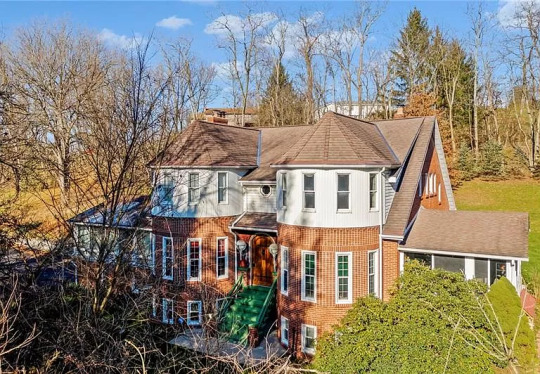

Here's a home that's kind of strange. It's an artsy home, but some of the art is unfortunate (think kitchen cabinets). Built in 1953 in Monongahela, Pennsylvania, it has 5bds, 3ba, $750K. Have you ever seen such unique light fixtures?
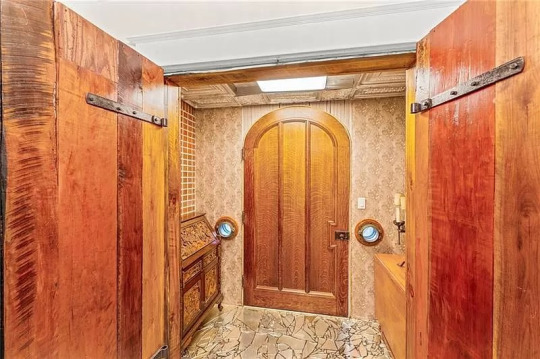
Isn't this a unique entrance foyer- note the 2 little portholes in the wall.
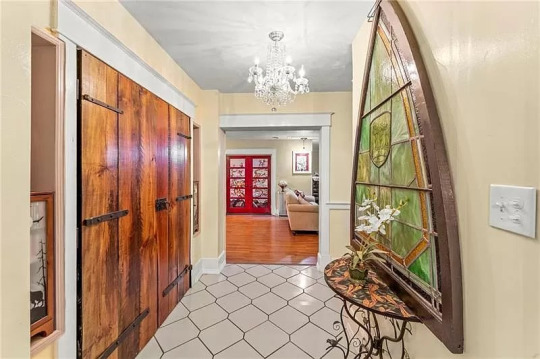
The entrance hall has a closet for coats, etc.

The living room is huge and has a stone fireplace painted black so it kind of looks like logs. Note the murals on the doors and the gold border on the ceiling.
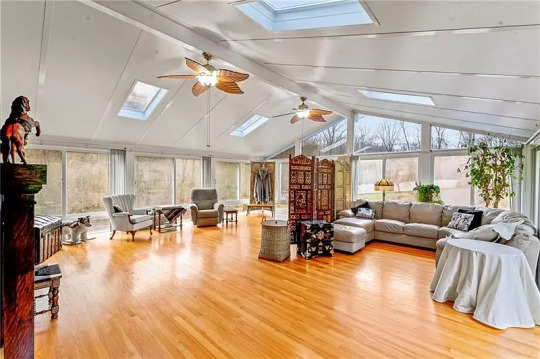
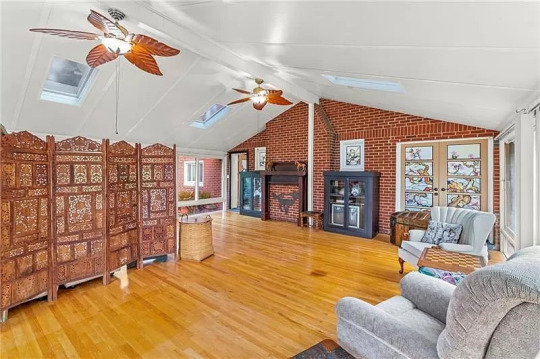
There's also a very large sunroom. At one end is a brick wall and some more murals on the doors match the theme in the living room.
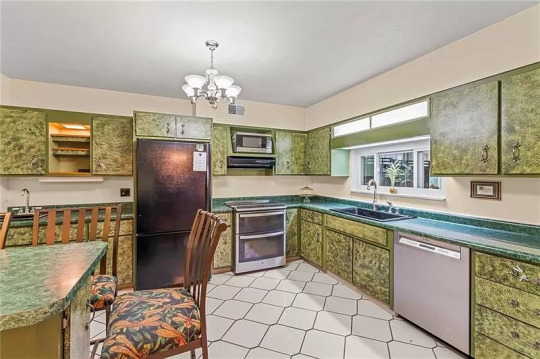
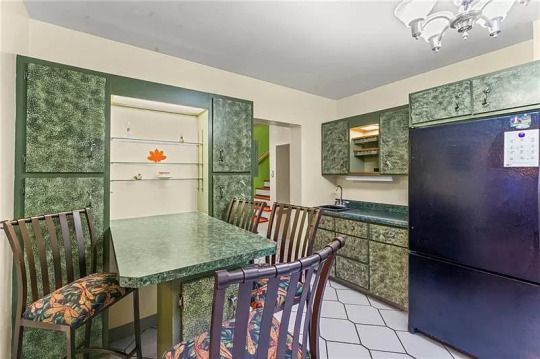
And, this is where art goes awry. Someone smeared green paint all over the cabinets.
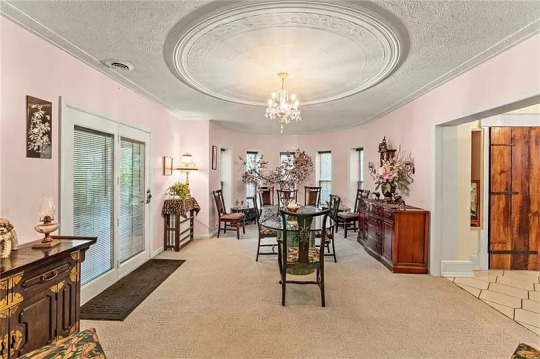
The rooms in this home are gigantic. Here's the dining room with the largest ceiling medallion I've ever seen.

The guest powder room has a lovely pedestal sink.

This looks like maybe a rec room. It is also a huge space and has a partial copper ceiling.
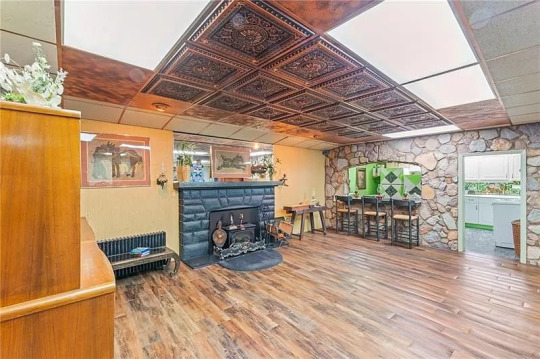
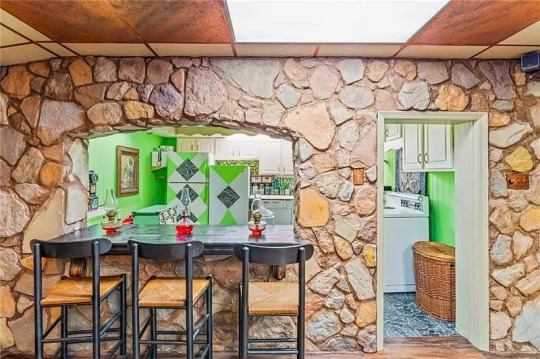
A stone wall with a counter for the second kitchen.


The artiste did a design on the appliances and a cabinet. It's roomy for a 2nd kitchen, though. Love the antique stove.
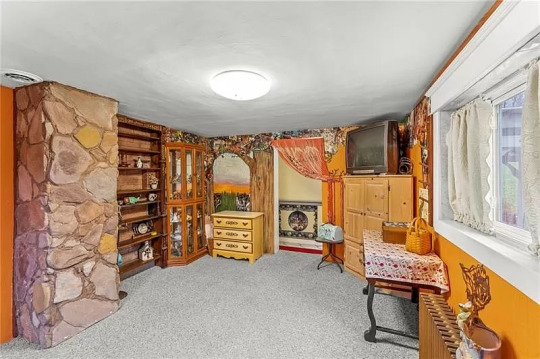
I don't know what this room is.

Nor do I know what this room is. It looks like it may be some sort of office.
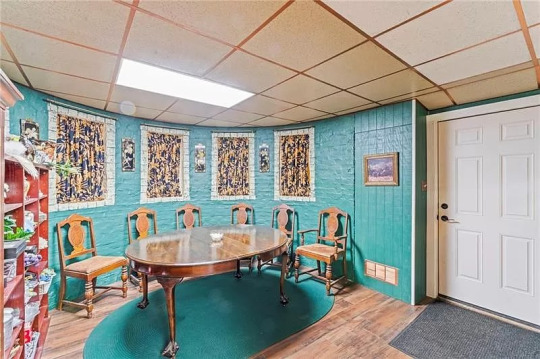
I don't know, Maybe they do crafts around this table.
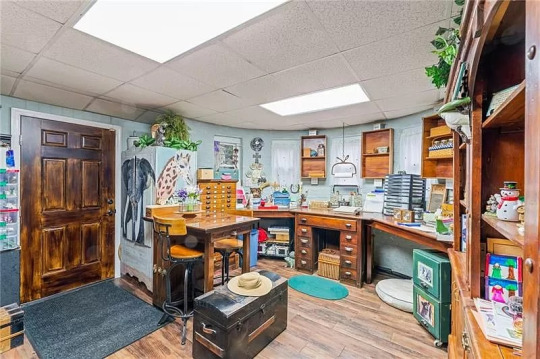
This is definitely an arts & crafts space.

Bathroom that's been given a nautical theme.
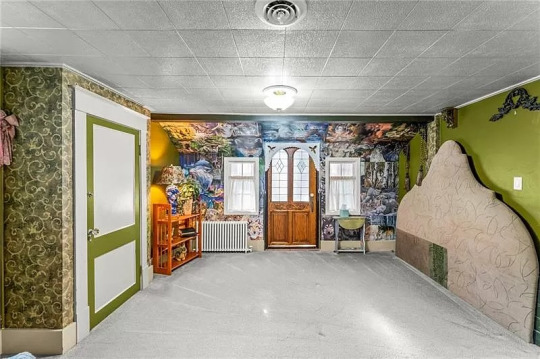
Perhaps this is a bedroom? Could that huge thing be a headboard?


I am so confused in this funky house. Both of these round rooms have an upholstered border around the bottom. I have no idea what that's for.
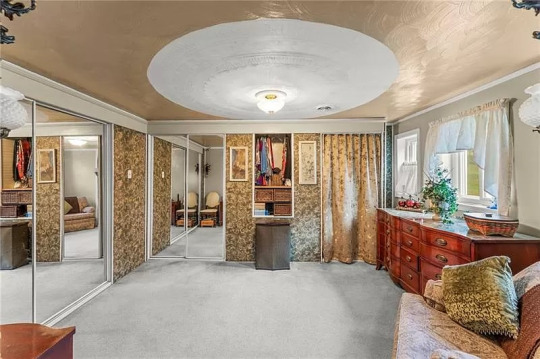
Another bedroom?

This has to be a bedroom.
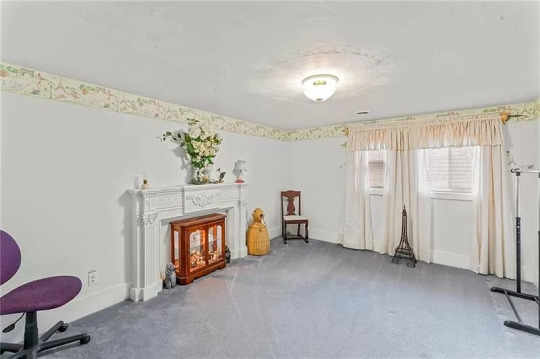
In the fireplace there appears to a lighted display case.
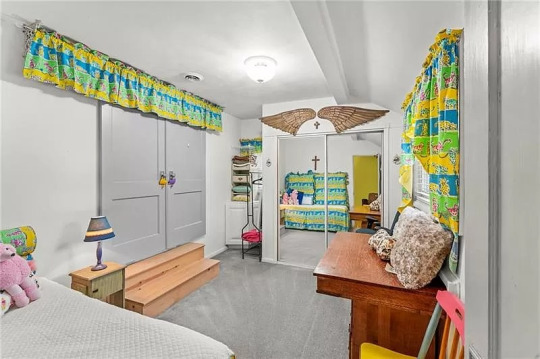
This bedroom has 2 steps down. It's a child's room, but it looks so isolated.
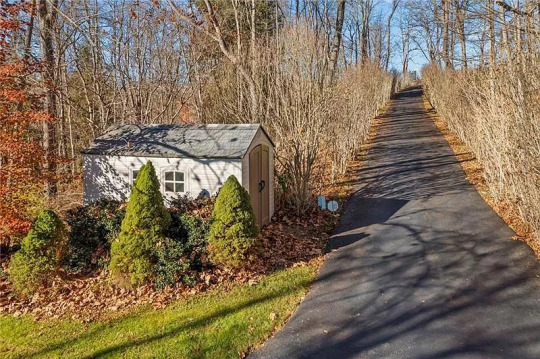
I don't know if that's a road or a driveway, but there's a cute little shed.

There's a lot of land, 5.50 acres.
https://www.zillow.com/homedetails/1255-Keenan-Hill-Rd-Monongahela-PA-15063/49752946_zpid/
107 notes
·
View notes
Photo

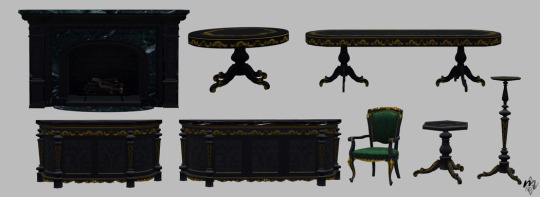
• .package • Base game compatible • Collection file included •
• 𝔻𝕆𝕎ℕ𝕃𝕆𝔸𝔻 • Ad-free as always at my website!
🤍𝕂𝕠-𝕗𝕚 𝕥𝕚𝕡𝕤 𝕛𝕒𝕣 | ℙ𝕒𝕥𝕣𝕖𝕠𝕟🤍

【 ℂ𝕣𝕖𝕕𝕚𝕥𝕤 】
Mesh and textures: @strangestorytellersims
Original Sims 4 post: ⚪
• Polycount, buy category, price § and more useful information ↓ •
* Chair: 2324 verts | 2728 faces
>> Found under Dining chairs | 330§
>>> Recolorable - 3 channels
* Fireplace: 3493 verts | 2611 faces
>> Found under Fireplaces | 7000§
>>> Not recolorable - 22 presets
* Oval Table: 2499 verts | 2702 faces
>> Found under Dining tables | 2900§
>>> Recolorable - 2 channel
* Pedestal: 1273 verts | 1386 faces
>> Found under Miscellaneous surfaces | 990§
>>> Recolorable - 3 channels
>>>> 5 slots for Small/Medium/Large objects
* Round Table: 1426 verts | 1552 faces
>> Found under Dining tables | 1200§
>>> Recolorable - 2 channel
* Sideboard 1: 2138 verts | 2108 faces
>> Found under Miscellaneous surfaces | 2050§
>>> Recolorable - 3 channels
>>>> 21 slots for Small/Medium/Large objects
* Sideboard 2: 2222 verts | 2150 faces
>> Found under Miscellaneous surfaces | 2300§
>>> Recolorable - 3 channels
>>>> 21 slots for Small/Medium/Large objects
* Wine Table: 1061 verts | 1216 faces
>> Found under Miscellaneous surfaces | 1020§
>>> Recolorable - 3 channels
>>>> 9 slots for Small/Medium/Large objects
#thesims3#sims3#ts3cc#s3cc#4to3#s4tos3#strangestorytellersims#comfort#surfaces#diningroom#fireplaces
234 notes
·
View notes
Text
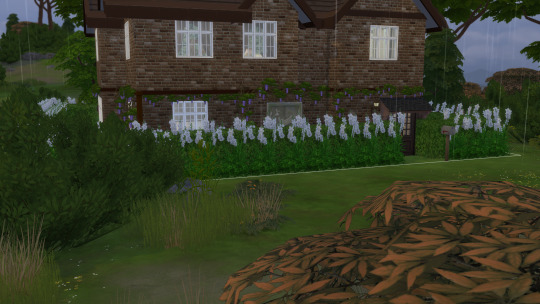

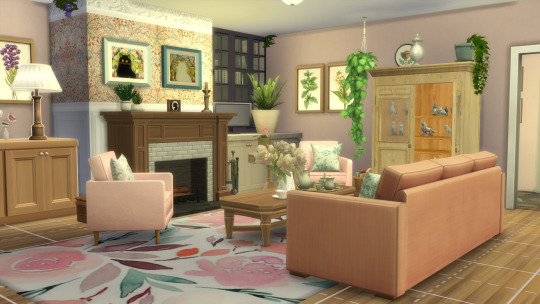


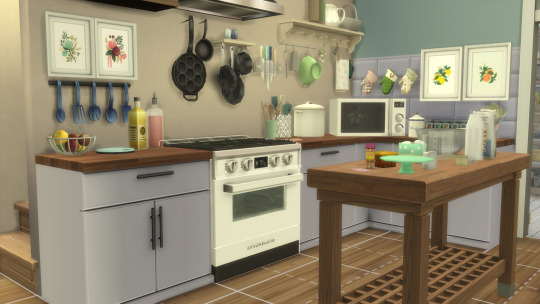
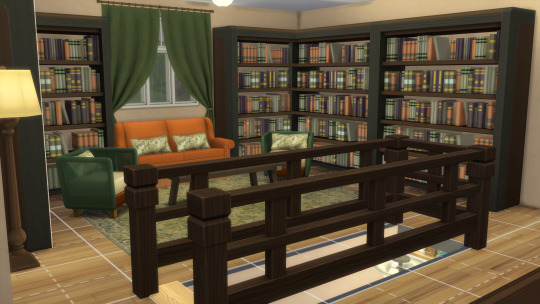

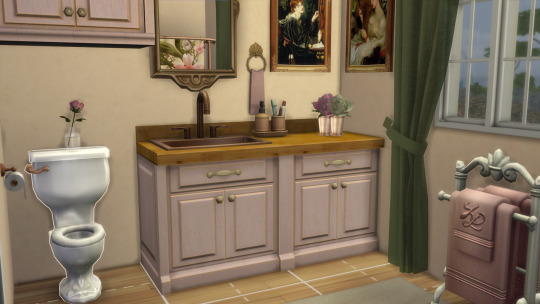

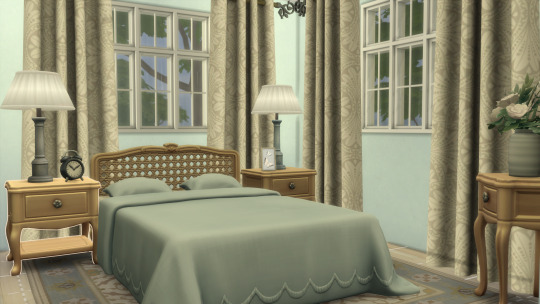

A CC filled lot this time. English-ish House is up on the gallery. 3 bed, 2.5 bath, with a pantry and laundry room. ID jeanbury. All the CC used is written below. Beware, it's a long 'un!
876 simmer-Oslo wardrobe, lowboy dresser, nightstand and standing mirror.
9 sims-DIY stars wall hanging.
Adrestea Moon-Storybook Lover and PJR Paintings.
Ars Botanica-Peonies Pitcher and Peony Jule Cup.
Ameyasims-You're So Vain: Vanity Brush and Hand Held Mirror.
ATS4-Breakfast: Milk Pack, Coffee Jars, Coffe Jar, Milk Bottle, Instant Drink, Tea Tin, Tea Box, Cocoa Powder Box. Fruit Juice Packs, Fruit Juice Glass Bottle, Coffee Bag. Baking: Wooden Spoon,Mechanical Scale, Timer, Canister, Baking Decoration Jar, Dried Fruits, Mixing Bowl, Baking Aids, Flour, Nutella, Baking Aids Stock, Dried Fruits Stock, Electronic Scale, Measuring Cup, Sugar, Jar, Measuring Cups, Rubber Spatula, Pastry Wheel, Candied Fruits. SnowyDay: Gloves, Wall Scarf #2, Wall Beanie #1, Fur Boots, Boots Snowcalf, Wall Coat #1 and #2 Bag Clutter: Tic Tacs.
Awingedllama-Apartment Therapy Potted Vine Round Mirror, Hanging Ivy.
Charley Pancakes-Insomnia: Organic Cotton Bedding. Miscellanea: Book Collection, Standing Books, Book Series.
Desimmy-Tiny Nifty Pictures.
Dew At Home-Hallway Hanging Scarf.
Duckey-Springtime Melody ,mug, Forever Spring Canvas Art, Lil Lilies, Friends and More Friends(these are table mounted frames that are called friends. That's all the information that was given)
Faaeish-BB Wall Decor Pegs and Toy Camera.
Felixandre-Chateau: Alarm Clock, Bedding, End Table, End Table 2, Drawer, Table Lamp, Rug Square, Telephone, Dresser. Grove: Salad Bowl, Lady Sam's Peony Vase, Bedframe V1. Grove-Timbershelf Inside Corner, Flagstone Floor, Cups, Stacked Plates, Stacked Plates 2, Stacked Plates Small, Wall Basket Small, Casserole, Bowls.
Felix and Harrie-Livin Rum: Box Files, Rug, Book Row, Book Series. Orjanic: Table Lamp, Bench, Cushion 2, Book End. Baysic: Toothpaste Container. Florence Fresco Mural. Tiny Twavellers:Hedge Wall.
GhostlyCC-Pre Raphaelite Paintings.
Harrie-Coastal Kitchen: Cereal Boxes, Cabinet Stack, Accent Counter 1 Marble Type, Coastal: Farmhouse Kitchen Sink with Tea Towel, Tins, Sofa, Tv Unit, Display Cupboard, Small Plates, Bowl, Bowl Stack, Cans, , Large Plates. Heritage: Traditional Towel Ring, Bowl Traditional Toilet, Traditional Runner, Landscape Artwork, Traditional Console Table, Floor Lamp, Traditional Round End Table, Traditional Elegant Mirror Small, Traditional Desk, Traditional Bust. Country: CoffeeTable.
Haruinosato-2x1 Curtain 01 Short.
Javabeandreams-Whimsical Animal Portraits.
Kardofe-Vienna Dining Room Curtains, Bella Babies Bedroom Small Pics.
Kliekie-Yove Plants 06, Awipow Plants 11, DecorationsPlants 10 Dragon's Herb. Whisper Laurel Plants 05
Kriss-Scania Build Set:Windows Classic Colonial 2 Tile, Classic Estate 2 Tile,Jugend Cottage 2 Tile.
Leafmotif-Botanical Bathtub, Twee Tableware: 6 Egg bowl, 9 Pot with Lid, Twin Mug Stacks, Whimsy Cake Plate, Short Pitcher. Basil's Favourite Chair 3 Maud Lewis Paintings
Linacherie-Ts2 Olde Tyme Skillets, Billyjean Curio Kitchen: Trays, Clip, Jar. Simlish Art 11, RPC Prints, Sizzling Cuisine Mitts, Delicious Bakery: Cookbooks, Flour Bag.
Madame Ria-Back To Basics: Spice Bottle,Dish Rack, Cereal Box, Pot Holder Wall, Modular Shelves, Coffee Tin, Pot Holder, Stock Pot, Dressing Container, Spice Rack, Counter Grey Scale, Open Book.
Marefc-Half Tiled Walls 2.
MC- Modern Crafter The Short Contemporary Radishly Plant
Menaceman 44-Granny's Brolly Vase.
Midsummersim-Simterest Poster.
Moonlightsim-Photo Frame Memories.
Nocturne-Rustic Cottage: Pokers, Master Curtain, Pedestal Old Miller Tea Set, Deco Retro Vacuum, Not So Shabby Rug, End Table. Grandma Cupboard.
Nynaeve Design-Lyne Half Curtains Blinds V1. Lyne Three Quarters Blinds V2, 1069, 1069 Lyne Radiator 1 Tile.
Okruee- ACNH Bathroom Towel Rack. (Animal Crossing)-
Omorfi Mera- Glass Jars.
PlasticBox- Modular Plant Hanging Pot.
Peacemaker-Hinterlands:Living Throw Pillow, Farmhouse Dining Table, Single Bedframe, Cottage Dining Chair, Bedside Table, Luxurious Single Bedding V1, Arched Mirror, Wardrobe, Bedframe with Footend, Nightstand. Hinterlands Living: Stately Fireplace, Coffee Tray Table, Mantle Mirror, Fringed Pouffe. Hinterlands Dining: Framed Dining Chair, Hanging Clock, Short Petal Pendant Porcelain Lamp.
Piersim- The Office Mini Pack: Higher Plant, Landline, Stackable Book, Printer.
Pocci-S Cargeaux Cabinet RecoloursCyclamen Outdoor, Iris Outdoor, Lilac In A Glass Bottle, Woodcabinet Open (Book cabinet Mini Set), Vintage Tea Set: Teacup With Tea, Milk Pitcher, Cupcake Plate. Magnolia Ceramic Vase, Basket Decor With Slots, Anthropologie Ottoman, Laundry Day Basket on Stool, Steaming Coffee Cup, Marguerite Teacup Empty, Iris In Glass Jar. Single Rose Glass Bottle. Potted Lily Of The Valley.
PTS-Cottage Garden Tea Tin Herbs, Granny's Basket Deco, Deco Mason Jar Short.
Quaylinsims- Paintings Zodiac.
Rhiannon AR-Medium Rug Floral Modern, Long Rug WithModern Floral Patterns
Ricca Bee-Mom's Lamp.
RSVN-Clothes Minded: Fedora, Floppy Hat, Baseball Hat, Sweater. Peg To Differ: Dish Towel, Knife Set, Mug, Utensils. Simmerdown: Cookie Jar, Mason Jar, Mug, Hanging Pots And Pans, Paper Towel, Ceramic Jar, Macaroon Jar. Smeglish Kettle Large.Procraftination:Hoop Large,
RoyIMVU-Seagrass Baskets.
Silverhammer-Executron Executive Desk Throne.
SimMan123-Sheer Right Curtain Short.
Sixam-Spring Six Kitchen: Buttery Toast, T Meg Mid Century Toaster With Toast, TMeg The Terrance, Deco Stove Hood, Olly's Oil Bottles, Kitchen Appliances Stove, Don't Be A Square Plate.
SJB (Yika)-Charlie Set Two CurtainsV1.
Soloriya-Zoe Blinds Part 2.
SYB-Colette: Towel, Toilet Paper Rolls, Soap Dispenser,Wallshelf, Bath, Blanket, Sink, Floor Vertical Mirror, Book, Cupboard, Rug, Bath Tray, Toilet.Millenial: Fridge, Fruit Basket,Utensils Rack, Utensils Pot, Totebag, Spices, Dish Soap. Microwave, Olive Oil, Breadbox, Island, Trashbin, Shower Curtains Short. Highschool Corridor: Hanged Backpack, Sandrine Slippers.
Tianella SE- Honey Herbs Paintings.
Veranka-Yesteryear Loveseat.
Wistful Castle-Wistful Room Pictures, Wistful Lamp #1.
Wondymoon-Cycnus Curtains.
Zeenasims- English Cottage: Paintings, Wainscotting Wallpaper.
ZX-Tagada-Lighting Table Candlestick.
6 notes
·
View notes
Photo
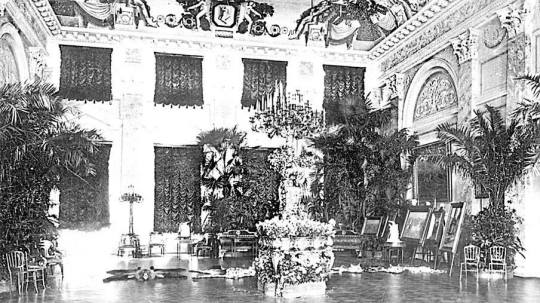








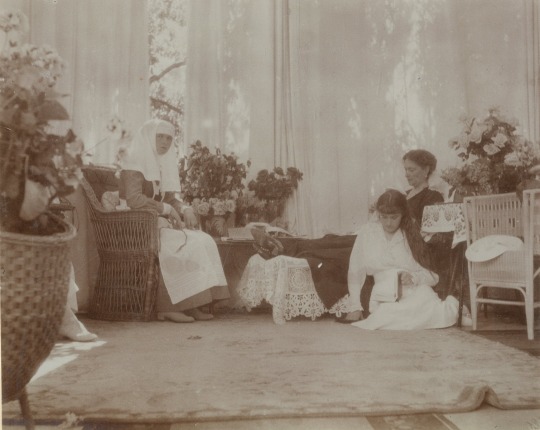
That photograph of the Parade Enfilade actually made me want to delve more so into the plant and flower decorations of the Alexander Palace, which there is a great deal of description. Via the publication, entitled "Tsarskoe Selo: Familiar and unfamiliar." Written by Galina Semenova, a former senior archivist (she passed away in 2014), and published in 2018, the book was republished with new information in 2010.
Mme. Semenova's work is an absolute treasure-trove of information on just about anything you could think of from the beginnings of Tsarskoe Selo to how it exists now. There is so much information, ranging from many, different topics.
As mentioned above, there is one chapter in particular which goes into great depth on the Alexander Palace's floral and plant decoration, which during the reign of Tsar Nicholas II played a large part of the lives of the Imperial Family. It's a bit on the long side, but I think it wouldn't be given justice if I only shared excerpts. Also, if you wish to read the original Russian (as I am translating this with Yandex), I shall link the book from a website where it can be read freely.
Please enjoy!
________________________________________________________________
"... And the shadow of patching flutters on the enamel
wall." Decorative plants in the decoration of the palace in the late XIX early XX centuries
"One of the photos of the Concert Hall shows how fan-leaved latanias looked in the interiors of the Alexander Palace. There were many huge palm trees, decorated in the form of compositions with evergreens. Two tall latanias are visible at the back wall. Their size can be determined by the window openings and the cornice, which passed at a height of 10 m and corresponded to the height of the currently existing front enfilade. The highest latania, therefore, had a height of 8-9 m, the one next to it – about 6 m.
It can be assumed that, in connection with the reconstruction in 1902, the latanias, along with the mahogany furniture set and the skin of one of the tigers, were moved from the Concert Hall in the Billiard Hall. In the Billiard room in front of the mirror portal located opposite a large triple window, under the last owners, a special box-a jardiniere - was still preserved from the previous owners. Adianthum, salanum and other plants were placed in it, which formed a miniature mixborder, reflected in the mirror along with park greenery and palm trees. The group with them was made up in the outer right corner and included fan-leaved majestic latanias, beautiful pinnate-leaved phoenixes or graceful hamedorea, as well as various types of dracaenae.
Flowers have long been placed in the Round Hall near the columns of golden artificial marble, during the time of Nicholas II – gracefully majestic pinnate palm trees of Kentia up to two fathoms each, to which flowering plants were selected. A date palm a fathom and a half high stood on a pedestal in front of the central door. Flowering plants, depending on the season, hydrangeas, azaleas, hyacinths, lilies of the valley and others were placed on marble window sills during ceremonial receptions, breakfasts and lunches. At Court, there was a tradition to seat guests at round dining tables, in the middle of which there was an opening for a tall palm tree or laurel placed on the floor in tubs. However, in the Round Hall, a round table was arranged, perhaps, around a large vase with a gilded bronze bouquet. Once a year, a Christmas tree, a representative of the northern flora, appeared here among exotic palm trees, on Christmas Eve.
The large Crimson drawing room, later turned into a church, was richly decorated with flowers under Nicholas I. The green composition was made in front of the window at the end of the hall, capturing the outer corner. Under Nicholas II, palm trees and other tropical plants were placed on the sides of the door from the Billiard Hall.
The portrait hall, which served as a reception room during the Highest exits at solemn ceremonies, was decorated with groups of tropical plants in the corners. Cut flowers filled large floor vases. A bouquet of roses decorated a round table, as can be seen in one of the pre-revolutionary photographs. A sofa and two armchairs with a table between them, a vase with roses, brought forward in front of the fireplace, seem to be prepared for a conversation with an important state guest.
A majestic palm tree in a jardiniere, the composition of which was complemented by climbing plants, monstera and croton with a bright glossy mottled color of the leaves, was part of the permanent decoration of the Corner living room, as one of the preserved pre-revolutionary photographs shows. A jardiniere with a tall feathery deciduous palm tree successfully decorated the doorway (there was a bookcase on the side of the Small Library in this place). The interior decoration was complemented by flowering plants in decorative vases on tables and consoles, which created a festive atmosphere during chamber music evenings held here.
Palm trees with tall, beautifully shaped crowns and blooming roses were interior-forming in the decoration of the Maple Cabinet. They made up a large composition with two marble sculptures, complemented by flowering and evergreen plants, which occupied a central place from the middle of the room to the front wall. However, lilac was also a frequent guest here, periodically replacing or complementing the decoration of rose bushes. Groups of palm trees in tubs with evergreens and flowering plants that were selected for them made compositions with sofas in front of the fireplace and stairs, the height and volume clearly corresponding to a high corner cabinet with mirrored glasses. Vases were filled with a variety of growing and cut flowers. A blooming white azalea in a conical white porcelain vase decorated a round table placed in the center of the room. The shelves of the corner sofa were decorated with vases and planters with growing ornamental plants, climbing plants decorated the barrier under the mezzanine, the paw-like leaves of palm trees were visible at the top through the fence of the mezzanine.
Bushes of flowering plants in pots and cut flowers in baskets and vases were placed on the terrace, which was accessed by a door from the Maple Study. Pelargoniums, hydrangeas and campanulas were most often chosen. At this terrace in the park there was a carpet shaped flowerbed of flowering stunted plants, broken in 1897 by architect S.A. Danini. In the spring, tulips, hyacinths, daffodils and other bulbous plants were mostly planted here, which remained here for the winter. In the spring after flowering, they were replaced by summer plants of different varieties and colors.
Permanent compositions of plants also dominated the decoration of the Lilac Cabinet. It is characterized by tall tub palms in jardinieres, the lower tier of which was decorated with blooming lilacs, but there were also roses. Tall pinnate palm (kentia?) it occupied half of the room with its leaves, it was placed in a jardiniere between a corner sofa and a piano. Three groups of palm trees, lilac bushes or roses and evergreens plants in the amount of up to 50 copies were compiled on the sides of the aisle at the door of the Rosewood reception room of the Empress. Among the greenery at the arched window there was a marble bust "Lily" of M. L. Dillon Square, 1900. There were always cut flowers in the office – roses, calla lilies in decorative vases on tables or on the floor. Bushes of flowering almonds were placed in floor vases, lilies of the valley in a large porcelain pot decorated the bookcase-library and were placed everywhere in vases. "Her Majesty's drawing room, known as Le Cabinet Mauve de'l Imperatrice, was a wonderful room, – a close friend of the Empress Lily Den wrote admiringly about the Lilac Study, – where one could observe her mistress's predilection for all shades of purple. In spring and winter, the air in it was saturated with the scent of lilacs and lilies of the valley, which were sent to the palace from the Riviera in whole baskets every day. Since the Empress's love for lilacs and lilies of the valley has already been noted, I want to add that Her Majesty was not indifferent to all flowers. But she was particularly attracted to lilies, magnolias, wisteria, rhododendrons, freesias and violets." To this we add that the scientific name of lilac is Syringa Lilac (Latin). But lilacs and lilies of the valley will be that, as if in winter and spring, "whole baskets were sent to the palace from the Riviera every day," this is an understandable exaggeration of the memoirist. The distillation of blooming lilacs, lilies of the valley and other flowers to decorate the interiors of the Alexander Palace was carried out by Tsarskoye Selo gardeners in the imperial greenhouses.
Some details of the appearance of green decoration in the interiors of the Alexander Palace are clarified by archival documents. Two jardinieres – plateaus for plants, one at the arched window, the second at the wall between the corner sofa and the piano, were part of the furniture decoration of the Lilac Cabinet of the Empress, made in 1895 by architect R.F. Meltzer by the firm "F. Meltzer". One jardiniere (measuring 3 m 74.5 cm long, 1 m 13 cm wide and 30 cm high), placed along the wall between the piano and a corner sofa, had two nested copper flower tubs. It was multi-faceted figured, with carved side walls and a smooth back. The second jardiniere (with a box and an iron flower tub enclosed in it) was also multi-faceted, decorated with carvings of acanthus leaves. Its dimensions are 1 m 82 cm long and 87 cm wide. In the middle there was a three-sided pedestal (height 1 m 32 cm) with cut corners, covered with lilac fabric "lampas" striped with bouquets of flowers (as a screen and furniture in this room). In the pre-war description, both jardinieres, painted with ivory enamel paint, are identified as Meltzer's work "in the style of a modernized rococo." Two semicircular plateaus for plants were also provided by R. Meltzer and in the Rosewood Reception Room of the Empress.
Subsequently, when the Maple Cabinet of the Empress was installed in 1902, as part of the furniture made of gray polished maple, the project of the architect of the Highest Court Roman Meltzer provided for such items as a large low jardiniere, in which a stand for a sculpture is indicated on the plan, and a small semicircular jardiniere. In addition, the documents list "a sofa with a tree", "a balustrade on an elevation with jardinieres for flowers" and three "armchairs with a tree" on the mezzanine. The "tree" undoubtedly meant palm trees, which can be seen in pre-revolutionary photographs. A huge pinnacled palm tree, almost reaching the cornice in height (about 5 m), was placed in the corner behind the sofa.
The first palm trees for the interiors of the Alexander Palace were accepted by the head gardener August Zort and examined by the Control of the Ministry of Foreign Affairs on October 25, 1895 from the "Supplier of the court of His Imperial Majesty and His Royal Highness Prince of Wales gardener G.F. Ailers (he himself signed in the bill as G.F. Ailers). The bill read: "Released for Tsarskoye Selo greenhouses: 2 Kentias Forsteriana for 120 rubles.; 2 Phoenix Canariensis for 120 rubles.; 1 Coconut Yatai for 150 rubles. A total of 630 rubles." The following year, 2 more kentias forsterians were received from Eilers for 200 rubles. The second supplier of palm trees was, oddly enough, the famous rose grower V.K. Freundlich. The Tsarskoye Selo Horticulture of V.K. Freundlich, crowned with laurels and medals for achievements in the field of horticulture (10 domestic and foreign medals are depicted on the letterhead), delivered two Phenix canariensis palm trees to the Tsarskoye Selo Palace Board by order of Mr. Zort for 85 rubles. In total, it was required to pay G.F. Eilers and V.K. Freundlich for nine palm trees necessary for the decoration of the interiors of the Alexander Palace, 1000 rubles. However, such expenses were not provided for.
To pay for them, correspondence was conducted between the head of the Tsarskoye Selo Palace Administration, V.E. Ionov, and an official for special assignments under the Minister of the Imperial Court as Chamberlain, Baron A.G. von Knorring. The invoices of the palm suppliers are attached to these letters. "For the decoration of the rooms of the Alexander Palace during Their Imperial Majesties' stay in Tsarskoye Selo," Ionov wrote to Knorring on January 25, 1896, "a very significant number of decorative, especially palm plants are required... Ornamental plants, after standing for a few time in the dry room air, away from the light, they turn yellow and then die; why, in order to avoid such damage, it is necessary to replace them with new ones in a timely manner." However, the necessary number of plants in the Tsarskoye Selo greenhouses was not available at that time, since the best palm trees from them were released in 1883, 1884 and 1887 to Peterhof and Tauride greenhouses. Ionov requested Knorring 's petitions for the release of the same plants from other palace greenhouses to Tsarskoye Selo or the same about the allocation of money for the purchase – about 2000 rubles. As a result of this petition, the Minister of the Imperial court, Count I.I. Vorontsov-Dashkov, allowed to open a loan in the amount of 1,000 rubles. on the account of unforeseen expenses in the following, 1897, for the purchase of ornamental plants for the rooms of the Alexander Palace during the stay of Their Imperial Majesties in Tsarskoye Selo379. And only after that, in 1898, the bills of Eilers and Freundlich.
In the future, the Tsarskoye Selo palace authorities had to take more active measures to ensure the permanent green decoration of the interiors of the Alexander Palace. In the first half of 1898, correspondence was conducted on the issue of "Buying palm trees and ornamental plants abroad, as well as perennial flowering plants in spring instead of the proposed greenhouse for 30 frames at the Alexander Palace." In the beginning, it was supposed to build new greenhouses with 30 frames for the maintenance of plants necessary for the decoration of the Alexander Palace. However, A.G. Knorring initially opposed the construction of a new greenhouse, since the survey showed that old greenhouses could be used. In the report, Knorring wrote that during the survey, it became clear that it was necessary to buy "new palm trees of different varieties for permanent decoration, without which it is absolutely unthinkable for the next winter to decorate the Alexander Palace during the Highest stay. General Ionov and I found it necessary to apply for permission to purchase the following palm trees in the amount of up to 5000 rubles." The "List of ornamental (palm) plants required for purchase for Tsarskoye Selo greenhouses in 1898", prepared by Zort and approved by Knorring, included 91 palm trees of different species. It was supposed to purchase latanias of borbonica, hamerops, corypha, rapis, hamedorea, kentias of Forsterian and Balmorean, phoenixes (dates), Romantsov and Yatai coconuts, as well as areca rubra and aurea. In addition, it was found that due to the need for constant maintenance of the flower garden in the proper form, a one-time expenditure of 1000 rubles is required for the purchase, according to the requirement of the gardener, of perennial spring flowering plants for the decoration of flower beds and 500 rubles for bulbs.
On June 30, 1898, the head of the Tsarskoye Selo Palace Administration submitted a report to the Minister of the Imperial Court, who was informed that a loan of 9,000 rubles. it is closed for the construction of flower greenhouses in a school garden institution for the cancellation of such a construction. The content of this report was as follows: "As for some necessary expenses for the improvement of the garden part, which I indicated in my note submitted to Your Excellency on May 19, to the D. of the Chamberlain A.G. Knorring, and which he intended to make at the expense of the said loan, then such expenses should be entered with a special presentation. In fulfillment of this , I have the honor to inform:
For the permanent decoration of rooms in Palaces during the Highest stay here, a very significant amount of decorative, especially palm plants, which the Tsarskoye Selo greenhouses do not abound, is required. On the contrary, when examined, there were many plants in them that, according to their forms, have never been used and cannot serve for the decoration of rooms in Palaces, but cause only unproductive expenditure on changing oak tubs, which cost from 10 to 15 rubles each. Meanwhile decorative plants, after standing for some time in dry indoor air, away from light, turn yellow and then die, why, in order to avoid such damage to them, it is necessary to replace them with new healthy specimens in a timely manner, and return the former ones to the greenhouses for a long correction.
Due to the extreme lack of good ornamental plants, without which it is absolutely unthinkable for the next winter to decorate palaces during Their Majesties' Highest stay in Tsarskoye Selo, it seems necessary, in accordance with the opinion of D. Chamberlain A.G. Knorring, to buy for Tsarskoye Selo greenhouses a significant number of new palm trees of different varieties, indicated in the submitted statement, suitable for staging in the rooms, [instead of] existing some ornamental plants as old and unsuitable for decoration. But in view of the high cost of the above-mentioned plants from St. Petersburg merchants who demand double and triple prices, I ask Your Excellency's permission to send a garden master Zort abroad next July for inspection and selection on the spot from well-known horticulturists (who have informed their prices for the available unique palms) of the required specimens, as well as for personal presence during packaging and sending the selected plants to St. Petersburg. ...For the purchase of plants, transportation and payment of duties, I ask you to open a loan "...". At the same time, I ask permission to purchase several perennial, spring flowering plants, which by the required time could be used for the decoration of flower beds in front of the Alexander Palace, regardless of the bulbs that are annually discharged each autumn.
At the same time, I undertake to report that the harvesting of new palm trees this year will cause some expense for the device of a temporary device for them in the department where New Holland plants are now placed until the construction of an extremely necessary palm greenhouse next year, which has now fallen into complete disrepair."
On a business trip abroad , the chief gardener of the Tsarskoye Selo Palace Board , A. Zort , left in July 1898 . In Leipzig, the gardener Wagner, he chose only 42 palm trees (instead of 91), the cost of which depended on the height and type (the most expensive were latanias). This purchase cost 9,630 marks together with packaging (350) and transportation (600) and completely exhausted the loan allocated for the purchase of palm trees.
To select other plants necessary for the design of compositions in the palace interiors and planting in the Alexander and Catherine Parks, Zort visited two gardening in Lubeck – F. Paulich, Stelzner and Schmaltz, and near Hamburg – gardening K. Stoldt in Wandbeck. The purchased plants totaling 3,810 marks were delivered by the Baltic Sea in September October 1898 on the steamers Neva, Tsar and Maria Luisa to the port of St. Petersburg and then to Tsarskoye Selo in the greenhouses "against the big garden" on Sadovaya Street.
The supplier of the main volume of flowers was gardening "Philipp Paulig. Kunst und Handels Gartnerei in Lubeck. According to the account of gardening, one cargo with live plants was sent from Lubeck on October 22, 1898 on the Maria Luisa. It contained lilac of French varieties – pinkish-purple "Karl X" and white "Marie Legre", as well as white terry varieties "Madame Lemoine" and light purple with a white center "Michel Buchner", which was intended, of course, to decorate the Lilac cabinet after distillation in greenhouses. Here followed lilies of the valley for distillation, almonds of the stamp and low, ordinary viburnum "Roseum" (the second name is viburnum "buldenezh"), broom, hydrangea paniculata.
A variety of azaleas and rhododendrons, anemones were delivered by the Tsar steamer from Lubeck to St. Petersburg and Tsarskoye Selo.
On the Neva by F. Paulikha was sent another batch of azaleas (indica) and rhododendrons, low roses and other indoor potted and garden crops, beautifully flowering and groundcover. Among them were Alpine aster, gentian, primroses, fragrant vespers (night violet), Siberian undergrowth, phlox, begonias, acalypha sanderiana – an evergreen plant with variegated leaf coloring for compositions with palm trees, doronicum plantain and Austrian, veronica, asparagus, fern.
Peach trees, as well as the best plant for the carpet – aubriette, veronica creeping and lydian ochitok with a variety of colored foliage, used in gardens as a groundcover, were purchased from the horticulture "J.S. Steltzner & Schmaltz Nachfolger".
Among the plants purchased abroad were orchids, which A. Zori chose in gardening "Von C. Stoldt. Cyclamen-Samenzuch, Orchideen-Kultur und Import. Wandsbek-Mariental, bei Hamburg". A small collection of these exotic indoor flowers included lycastus skinner orchids, Moss cattleya and intermedia, odontoglossum bicton, Lutes purpureum, Pescatori, slipper orchid.
A precedent was created by the purchase of plants abroad in 1898, and in the future plants were purchased abroad annually until 1913 inclusive, as evidenced by archival materials. From year to year, the range of purchased plants changed, the range of suppliers expanded. European horticultural firms willingly cooperated with the Tsarskoye Selo Palace Administration. Some of them started to correspond in Russian and even thanked them, receiving money transfers for the plants delivered after a long period of time, since payment was made after receiving and inspecting the goods, which was properly processed. Settlements with suppliers were carried out through the Moscow Merchant Bank, the St. Petersburg Agency of the French joint Stock company "Lyon Credit", etc. The palace authorities who acted as the customer, it was supposed to report annually on the purchases made abroad. The report reflected information about the subject of the order (usually live plants and bulbs were indicated), quantity, time of issue of the order and the time of receipt, the name of the companies and their location, the total cost of the order in Russia and abroad. In addition, it was necessary to indicate by whom the purchase was authorized and in what order, as well as the reasons for which it was deemed necessary to make a purchase abroad. The standard wording on the last point was usually stated as follows: "For lack of plants."
For example, we can compare the purchases of plants in 1898 and 1908, when 20 foreign firms supplied live plants for the amount of 10647 rubles, some of them – garden equipment and tools. The reason for placing orders abroad: "The best quality and cheapness, and for lack of cultivation of some items in Russia."
These were the horticulturists K. Cake and K. Petrik in Belgium, H. Hartmann in Copenhagen, M. Bremond and Barbier in France. Every year the purchase of plants was carried out in Germany, where the permanent partners were the large horticultural L. Shpet in Berlin, M. Shettelich (successor of F. Paulich) and A. Lindberg in Lubeck, O.Mann in Leipzig. Bulbous and an extensive assortment of plants were traditionally purchased in Holland – from "Polman-Moi" and Van der Mey, Van Zanten and Tsonen. It should be particularly noted that one of the Dutch flower companies – Fr. Ziegler (Erfurt and Harlem) – had the honorary title of supplier of the Royal Court in Russia, in 1908, amaryllis was purchased from her in Tsarskoye Selo. Flower seeds (in particular, mignonette seeds, violets) were purchased from E. Benari in Erfurt, Vrede in Luneburg, who also supplied violets in the form of living plants, as well as G. Arends. Individual purchases were made from E. Ziegler from Erfurt (lilies of the valley), Ketten from Luneburg (roses).
Of those plants that were purchased in 1898, purchases of many of them were repeated every day, including in 1908. Among them were azaleas, indica and rhododendrons, lilacs, roses, almonds, viburnum "buldenezh", begonias, ferns, copses. Especially impressive is the number of lilies of the valley, purchases of which have increased annually. There are also many new plants in the accounts.
The assortment of flowers purchased abroad for forcing in greenhouses, for use in interior decoration, for cutting and for planting in parks was very diverse. Beautifully blooming garden crops were constantly purchased in large quantities. In particular, these were tuberoses and carnations, daffodils, hyacinths, jonquils, lilies, gladioli, violets and galanthuses, ixia, crocuses, leucoma. A small number of plants were represented by heather, chrysanthemums, ardisia, daisies, which were probably intended for cultivation in the palace greenhouses. The largest was the number of lilies of the valley – 45,000, tulips – 42,500 bulbs.
Tulips in 1908 were purchased mainly in Dutch horticulture. They were intended for planting in the Alexander and Catherine parks, as well as for cutting. Many varieties of tulips, mentioned in the Dutch accounts in 1908, are still cultivated today. Then bulbs of terry tulips "Murillo" white arrived in Tsarskoye Selo colors with a pink coating, white with a pink tinge "La Reine", yellow "King of Yellow" and "My Trezor", red "Vermillion Diamond", bright red "Duke van Tol", crimson "Proserpine", dark pink "Salvator Rose". Of particular note is the only variety of tulips with an aroma – "Prince of Austria" orange-red colors with a yellow bottom.
In 1912-1913, the last purchase of foreign plants for Tsarskoye Selo took place. Among the suppliers were horticultural firms Martial Bremond (France), which delivered plants for 1091 francs, Barbier & Co. Orleans (Franse) – 639 francs, K.J. Kuyk (Gand Belgigue) – 1669 francs, M.van Waveren & Sohne (Millecom – Holland) – 10690 marks, Jac. Smits & C° (Holland) – 1663 marks Max Schetelig (Lubeck) – 9242 marks, Albert Lindberg (Lubeck) – 2226 marks.
In the gardening bill "Barbier and Co.", Orleans, dated October 23, 1912, only lilac was indicated in the amount of 639 francs, or, in terms of the exchange rate, 240 rubles 23 K., which was accepted by the chief Tsarskoye Selo gardener L. Rempin.
This batch of lilacs in 4145 bushes included almost the entire palette of colors in 32 names. There were several species here – common lilac, Persian, Meyer's hyacinth lilac, as well as many varieties of common lilac. Along with various shades of lilac, pink, purple, purple tones, a fairly large number of white lilacs should be noted, including also varietal lilacs – ordinary white and Persian white, "Marie Legre" and "Bertha Damman", as well as terry white – "Madame Lemoine" and "Jeanne d'Arc". The bills indicate time–tested old varieties - "Karl X", "Volkan", "Memory of L. Shpet", "Reaumur", "Mirabeau", "Michel Buchner", "Pasteur", "Toussaint Overture", "Victor Lemoine", "Abel Quarry", "Beauty Nancy", "President Loubet" and "President Grevy", they can be found from modern manufacturers. Several varieties named in the account of the Barbier company ("Waldeck Roshen", "Jacques Callot", "Negro", "Progress", "Othello", "Scipio Cochet", "Stadtgartner Rothpletz") have not yet been found in the reference materials.
Lilac was undoubtedly used not only to decorate the interiors of Lilac and Maple cabinets, but also as a garden crop. The descendants of those living plants that were used in the late XIX – early XX centuries may still be preserved in historical Tsarskoye Selo parks or in the city of Pushkin itself.
In 1913, the last delivery took place, which was stopped due to the First World War. The plants from the state halls were removed in the spring of 1917, from the private apartments –shortly after the removal of the royal family to Tobolsk. The museum exposition opened in the palace without plants. In preparation for the opening of the museum in 1918, all the jardinieres were removed from the front halls, partially left for display in private rooms."
________________________________________________________________
I hope that you will enjoy this wonderfully-written article, even if some parts may not read correctly (online translators can only do so much). Attached are various photographs, as well as, some of the autochrome negatives and a few paintings to convey the spirit of Mme. Semenova's incredibly in-depth chapter from her book.
____________________
Photographs:
1. The Concert Hall of Quarenghi's Parade Enfilade.
Silvio Danini. Circa. 1898-1902.
2. Aquarelle of the Marble Drawing-Room of Quarenghi's Parade Enfilade.
Luigi Premazzi. Circa. 1834.
3. Aquarelle of the Raspberry Living-Room of Quarenghi's Parade Enfilade.
Luigi Premazzi. Circa. 1864.
4. The Lilac Cabinet of Her Majesty. Circa. Pre-1917.
5. The Maple Living-Room of Her Majesty. Circa. Pre-1917.
6. The Maple Living-Room of Her Majesty. Circa. Pre-1917.
7. The Maple Living-Room of Her Majesty. Andrei Zeest. Circa. 1917.
8. The Semi-Circular Hall of Quarenghi's Parade Enfilade. Circa. 1909.
9. The Palisandre Drawing-Room of Her Majesty. Andrei Zeest. Circa. 1917.
10. The Balcony of Her Majesty. Circa. 1912-1916.
Sources:
"Tsarskoe Selo: Familiar and unfamiliar." - Galina Semenova. Published Circa. 2018, revised in 2010. (Царское Село. Знакомое и незнакомое)
GMZ Tsarskoe Selo (Государственный музей-заповедник «Царское Село»)
Gosfond (Государственный каталог Музейного фонда Российской Федерации)
Альбом Александры Федоровны, 1903-1908 гг
Альбом Александры Федоровны, 1912-1916 гг
“Consolidated Guards Battalion, and now His Imperial Majesty’s own consolidated infantry regiment on guard at the royal throne.” - Montvida Publishing House. Published, Circa. 1909. (Сводно-гвардейский батальон, а ныне собственный его императорского величества сводный пехотный полк на страже у царского трона)
Link of courtesy: (VPN's work for websites that are currently blocked, I've been told)
http://loveread.ec/view_global.php?id=94414
https://www.flickr.com/.../14955.../albums/72157689613182040 (1903-1908)
https://www.flickr.com/.../14955.../albums/72157664081316757 (1912-1916)
http://elib.shpl.ru/.../26709-svodno-gvardeyskiy-batalon...
https://tzar.ru/
https://goskatalog.ru/
________________________________________________________________
As always, please enjoy! If you'd like to re-post the photographs PLEASE credit Galina Semenova, GMZ Tsarskoe Selo, GARF, Gosfond, Luigi Premazzi, Ilya Grigoriev and Andrei Zeest, appropriately. Thank-you! ^_^
#alexander palace#tsarskoe selo#gmz tsarskoe selo#romanov#imperial russia#galina semenova#russian archival material#russian books#gosfond#andrei zeest#russian state archives#ilya grigoriev#photographs#aquarelle#watercolour#luigi premazzi#flowers#plants#horticulture#plant talk#empress alexandra feodorovna#research post
10 notes
·
View notes
Note
Common design elements include:
Top surfaces of various shapes, including rectangular, square, rounded, semi-circular or oval
Legs arranged in two or more similar pairs. It usually has four legs. However, some tables have three legs, use a single heavy pedestal, or are attached to a wall.
Several geometries of folding table that can be collapsed into a smaller volume (e.g., a TV tray, which is a portable, folding table on a stand)
Heights ranging up and down from the most common 18–30 inches (46–76 cm) range, often reflecting the height of chairs or bar stools used as seating for people making use of a table, as for eating or performing various manipulations of objects resting on a table
A huge range of sizes, from small bedside tables to large dining room tables and huge conference room tables
Presence or absence of drawers, shelves or other areas for storing items
Expansion of the table surface by insertion of leaves or locking hinged drop leaf sections into a horizontal position (this is particularly common for dining tables)
(Family guy death pose part 2 electric boogaloo god damn)

2 notes
·
View notes
Text
What Are the Key Features to Look for in a Custom Dining Table?
When it comes to designing the perfect dining space, the dining table is more than just a piece of furniture; it’s the heart of your home. Whether you're hosting a family dinner, a festive gathering, or simply enjoying a quiet meal, your dining table plays a central role in creating memorable experiences.
With a custom made dining table, you have the opportunity to tailor this essential piece to your exact preferences and needs. But what key features should you look for when commissioning a custom dining table? Here’s a comprehensive guide to help you make the right choices.
1. Material Matters
The material of your dining table not only affects its appearance but also its durability and maintenance needs. Popular options include:
Solid Wood: Known for its timeless appeal and sturdiness, solid wood tables, like oak, walnut, or maple, are classic choices. Each type of wood has its own unique grain patterns and colours, which can add character to your table.
Reclaimed Wood: For an eco-friendly and rustic option, reclaimed wood offers a charming, weathered look that adds warmth to any space.
Metal: Sleek and modern, metal tables, particularly those made of stainless steel or iron, are durable and can create a contemporary aesthetic.
Glass: A glass-topped table can give a room an open and airy feel, making it ideal for smaller spaces. However, it requires frequent cleaning to maintain its pristine appearance.
When selecting the material, consider not just the look but also how it will fit into your lifestyle. For instance, if you have young children, a material that’s easy to clean and resistant to scratches might be more suitable.
2. Size and Shape
The size and shape of your dining table should complement the dimensions of your dining area and accommodate the number of people you expect to seat regularly.
Rectangular Tables: These are the most common shape and work well in long, narrow rooms. They provide ample seating and are perfect for large gatherings.
Square Tables: Ideal for square rooms, these messmate bedside table offer a more intimate dining experience, allowing everyone to face each other.
Round Tables: Round tables are great for smaller spaces and promote conversation, as there’s no head of the table. However, they may not accommodate as many people as rectangular tables.
Extendable Tables: If you frequently host guests, consider an extendable table. This type of table allows you to adjust the size as needed, offering flexibility without compromising on style.
Be sure to measure your dining space carefully and account for the additional space needed for chairs and movement around the table.

3. Design and Style
The design of your custom made dining table should reflect your personal taste and complement the overall aesthetic of your home. Consider the following elements:
Leg Style: The legs of a dining table can significantly impact its style. Options range from traditional turned legs, which add a classic touch, to more modern, sleek metal legs. Some tables feature pedestal bases, which offer more legroom.
Edge Profiles: The edge of the tabletop can be customised for a subtle design detail. Choices include bevelled, rounded, or live edges. A live edge, which retains the natural shape of the wood, can add a unique, organic feel to the table.
Finish: The finish you choose will affect the table’s colour, sheen, and resistance to wear. A matte finish offers a more natural look, while a glossy finish can make the wood’s grain pop. Stains can alter the wood’s colour, while paint can give the table a more modern or playful appearance.
4. Functionality
A custom dining table should not only be beautiful but also functional. Think about how you will use the table daily and during special occasions. Here are some functional considerations:
Storage Options: Some messmate bedside table come with built-in storage, such as drawers or shelves, which can be handy for storing table linens, utensils, or serving dishes.
Durability: Consider the table’s construction. How the joints are made, the thickness of the tabletop and the quality of the materials will all contribute to the table’s longevity.
Ease of Maintenance: Depending on the material and finish, some tables require more upkeep than others. For example, a glass table may need frequent cleaning, while a wood table might require periodic polishing to maintain its lustre.
5. Budget
Finally, your budget will play a significant role in the features you can include in your custom dining table. Custom furniture can range widely in price, depending on the materials, size, complexity of the design, and the craftsmanship involved. It’s important to balance your desire for quality and uniqueness with what you’re willing to spend.
Final Thoughts
A custom made dining table is an investment in both your home and your lifestyle. By carefully considering the material, size, shape, design, functionality, and budget, you can create a piece that not only fits your space but also enhances the way you live.
Whether you’re looking for a rustic centrepiece for family gatherings or a sleek table for modern entertaining, the right custom dining table will bring your vision to life and become a cherished part of your home for years to come.
Source by - https://shorturl.at/HWTUK
0 notes
Text
How to Choose the Perfect Teak Dining Table for Your Home
Introduction to Teak Dining Tables
Teak wood has long been prized for its durability, natural beauty, and versatility, making it an ideal choice for dining tables. Whether you prefer modern sophistication, rustic charm, or timeless elegance, a teak dining table can enhance your dining space while offering longevity and aesthetic appeal.

Characteristics of Teak Wood
Durability and Strength
Teak wood is renowned for its durability and strength, making it suitable for both indoor and outdoor furniture. Its natural oils and dense grain structure contribute to its resistance to rot, moisture, pests, and harsh weather conditions.
Natural Aesthetic Appeal
Teak's rich golden-brown color when new, which weathers to an elegant silver-gray patina over time, adds warmth and character to any space. Its fine, straight grain and natural luster enhance its aesthetic appeal, making it a prized material for furniture.
Sustainability and Environmental Benefits
Teak is sourced from sustainably managed plantations, ensuring responsible harvesting practices and minimal environmental impact. Its longevity and recyclability contribute to its eco-friendly reputation, appealing to environmentally conscious consumers.
Factors to Consider When Choosing a Teak Dining Table
1. Size and Space Considerations
Dining Space: Measure your dining area to determine the appropriate size of the table. Consider leaving enough space around the table for chairs and movement.
Seating Capacity: Determine how many people you need to accommodate regularly. Teak dining tables come in various sizes, from intimate settings to large family gatherings.
2. Style and Design Preferences
Aesthetic Preference: Choose a teak dining table that complements your home's decor style, whether modern, traditional, rustic, or eclectic.
Table Shape: Consider round, rectangular, or square shapes based on your space and seating preferences.
Leg Style: Select table legs or base designs that align with your aesthetic preferences, such as pedestal, trestle, or straight legs.
3. Quality and Craftsmanship
Wood Grade: Opt for Grade A teak, known for its superior quality and minimal imperfections. Grade A teak ensures durability and longevity.
Joinery and Construction: Examine the craftsmanship, including joinery techniques and finishing details, to ensure sturdy construction and aesthetic appeal.
4. Practical Considerations
Maintenance: Evaluate the maintenance requirements of teak dining tables. Teak's natural oils provide some protection, but regular cleaning and occasional oiling may be necessary to maintain its appearance.
Versatility: Consider how the table will be used beyond dining, such as for gatherings, homework, or crafting activities.
Budget: Set a budget that balances quality, design, and functionality. Teak dining tables are an investment piece that can provide long-term value and enjoyment.
Maintenance Tips for Teak Dining Tables
Proper maintenance preserves the beauty and integrity of teak dining tables, ensuring they remain functional and aesthetically pleasing over time.
Cleaning and Care
Regular Cleaning: Wipe the table surface with a damp cloth and mild soap to remove dust, dirt, and spills.
Avoid Harsh Cleaners: Refrain from using abrasive cleaners or chemicals that can damage the wood's natural oils and finish.
Teak Oil Application: Apply teak oil periodically to maintain the wood's color and protect it from drying out. Follow manufacturer recommendations for frequency of application.
Protection from Elements
Indoor Placement: Place teak dining tables indoors or in covered outdoor spaces to minimize exposure to direct sunlight and rain.
Use Coasters and Placemats: Protect the table surface from hot dishes, moisture, and scratches by using coasters, placemats, and tablecloths.
Seasonal Care
Winter Storage: Consider storing teak dining tables indoors or using furniture covers during winter months to protect against freezing temperatures and excess moisture.
Case Study: Choosing Teak Dining Tables from Crate & Barrel
Introduction to Crate & Barrel
Crate & Barrel is known for its stylish and quality furniture offerings, including teak dining tables that blend functionality with aesthetic appeal.
Key Features of Crate & Barrel Teak Dining Tables:
Design Variety: Offers a range of teak dining table designs, from contemporary to classic styles, catering to diverse home decor preferences.
Quality Assurance: Ensures high-quality craftsmanship and materials, including Grade A teak, to guarantee durability and longevity.
Customer Satisfaction: Provides comprehensive product information, customer reviews, and support to assist in selecting the perfect teak dining table for your home.
Maintenance Tips from Crate & Barrel:
Care Instructions: Offers care guidelines and recommendations for maintaining teak dining tables, including cleaning methods and protective measures.
Customer Support: Access to customer service for inquiries regarding maintenance, warranty coverage, and additional product care information.
Conclusion
Choosing the perfect teak dining table involves careful consideration of size, style, quality, and maintenance requirements to ensure it complements your home and lifestyle. Teak's durability, natural beauty, and sustainability make it an excellent investment for dining furniture that can withstand years of use and maintain its aesthetic appeal. Companies like Crate & Barrel exemplify these qualities through their range of teak dining tables, providing options that cater to different design preferences and practical needs. By selecting a teak dining table thoughtfully and maintaining it properly, you can enhance your dining experience and enjoy a timeless piece of furniture that enriches your home environment for years to come.
0 notes
Text
Luxury Round Dining Tables in Australia
When looking for the best round dining tables, take into account the gorgeous large round dining table alternatives that are available, which are great for entertaining. Any dining area is made more sophisticated by the classy round pedestal dining tables that are available in Australia.
For those needing flexibility, a round extendable dining table in Australia offers the perfect solution, effortlessly adapting to your space requirements. Mark Alexander Design tables blend craftsmanship and practicality, making them an exceptional choice for your dining needs.
Explore these beautifully crafted tables that combine tradition with modern design, and discover how they can elevate your dining experience. Visit frenchtable.com to learn more about how these bespoke tables can be customized to suit your home.
Mark Alexander Design with a team designs bespoke tables, each piece is entirely hand-crafted and finished in Australia to a premium level of quality. Combining style with functionality, these custom-made tables are tailored to suit your requirements regarding dimensions, parquetry design, colour, and finish. Made to the highest standard, every table ensures a perfect, high-quality product. Each is a unique piece of hand-crafted art.
#French Tables#Parquetry Dining Tables#Rectangle Dining Tables#Round Parquetry Dining Table#Extension Dining Tables#French Coffee Tables#French Chairs#Custom Made French Dining Chairs#Australian Made Dining Chairs#Classic French Dining Chairs#Parquetry Dining Table Adelaide#Parisian Round Dining Table#French Round Dining Table#French Furniture Melbourne#French Dinning Table#Pedestal Dining Table Australia#Oak Parquetry Dining Table#French Oak Dining Table#French Style Dining Table#Round Pedestal Dining Table Australia#Parquetry Dining Table Melbourne#French Dining Table And Chairs#French Style Coffee Table#Parquetry Dining Table Australia#Parquetry Tables#Wingback Dining Chair#Octagon Dining Table#French Sideboard#Console Tables Australia#Dining Tables Melbourne
1 note
·
View note